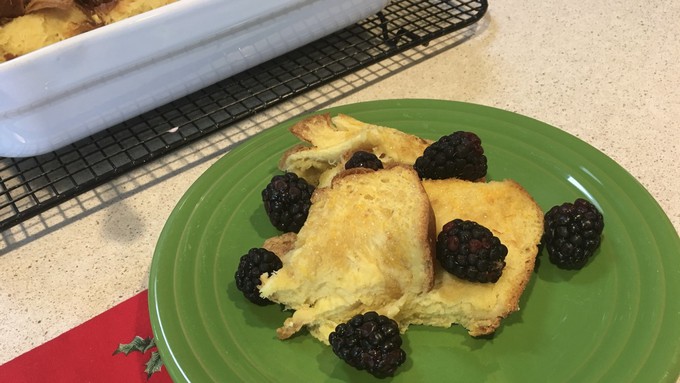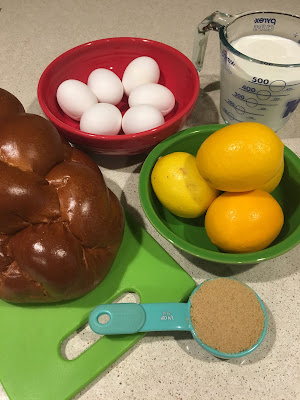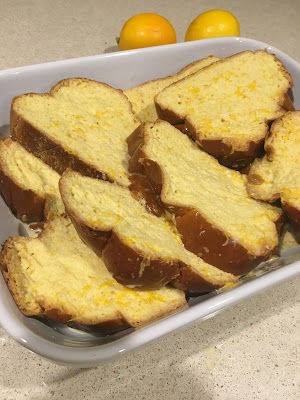
Recipe: Brighten a winter morning with a citrusy baked main dish

Baking French toast is so much easier than standing at the stove, turning each piece. Kathy Morrison
Winter's golden citrus is just showing up at farmers markets and produce sections. Maybe in your garden, too, since the Meyer lemon is such a popular tree to grow in California.
My tiny container tree never produces many lemons, but for years I could count on one co-worker or another bringing in bags or boxes of the lovely floral citrus from a backyard tree. I took as many as I dared, because they are a great fruit for cooking and baking. I'm not alone: Professional chefs love this lemon for its smooth, edible skin and its sweet, rather than tart, flavor profile.
Meyer lemons are named for Frank N. Meyer, the USDA explorer who found them in China and brought them to California in the early 20th century. The original Meyer -- believed to be a cross between a mandarin and a tart lemon -- was later found to be a symptomless carrier of viruses fatal to citrus fruit, and most of the trees were destroyed.

However, a virus-free stock was discovered. It was later certified by the University of California and became the "improved" Meyer lemon that we all grow and love now.
With Christmas approaching, I looked for a recipe that would work for Christmas breakfast or any holiday gathering when you don't want to stand over the stove while everyone else is relaxing or opening presents.
Baked French toast fits that bill, because it is prepped the night before and then popped into the oven the next morning. About 45 minutes later, you have a great breakfast dish that pairs beautifully with berries.
You can gild the lily and add powdered sugar and syrup, but this French toast is delicious without any of that.
The recipe is adapted slightly from Williams-Sonoma. I used the recommended challah bread, but it also would work with thick slices of brioche loaf (Trader Joe's sells an excellent version) or an artisan sourdough round. Just make sure the bread isn't too fresh -- if it is, slice it at least an hour ahead of preparation and let it sit out, or put the slices on a cookie sheet and pop them into a barely warm oven for half an hour or so. The bread will soak up the custard much better that way.
Meyer lemon baked French toast
Serves 6 to8
Ingredients:
Unsalted butter for pan
6 eggs, lightly beaten
2 cups half and half or nondairy milk
1 tablespoon

vanilla (see note below)
Grated zest from 2 Meyer lemons
1/4 cup firmly packed light brown sugar
1 16-ounce loaf challah, brioche or other artisan bread, cut into 1-inch slices
Demerara or other crunchy sugar, for sprinkling
For serving, optional:
Powdered sugar
Fresh berries (blackberries are ideal)
Maple syrup
Instructions:
Grease a large casserole dish or 9-by-13-inch baking pan; set aside.
Crack the eggs into a large bowl; beat lightly with a whisk or fork. Beat in the half and half, vanilla, lemon zest and light brown sugar.
Dip one bread slice at a time into the custard mix, turning to coat both sides. If the bread is not absorbing the liquid quickly, let it sit there for 1 or 2 minutes. Put the slices in the prepared pan, overlapping slightly. When all the slices are prepared, pour the remaining custard mix evenly over the bread slices. Cover the pan with aluminum foil and refrigerate, overnight or at least 2 hours.
When ready to bake, preheat oven to 350 degrees. Remove pan from refrigerator and, keeping the foil in place, put the pan on a rack in the center of the oven. Bake for 30 minutes. Remove foil and sprinkle about 1 tablespoon of the coarse sugar over the slices. Continue baking uncovered for 15 more minutes, or until French toast is puffy and the bread slightly brown on top.
Let the dish rest for about 5 minutes. Cut or scoop out the French toast and serve with desired toppings and fruit.
Note: Real vanilla extract is so pricey these days, 1 tablespoon may seem like too much. I gave up on buying it in the store and began making my own extract last year. (I put 4-5 vanilla beans, ordered online, in 1 pint of vodka in a Mason jar, stored in a cool place for as long as it takes to taste of vanilla. Bourbon works, too.) If you don't want to use so much of your precious vanilla in this, I'd recommend using just 1-1/2 teaspoons of extract, augmented with 1-1/2 teaspoons white rum or maple syrup. With all the lemon zest in this, that will be enough.
Comments
0 comments have been posted.Sacramento Digs Gardening to your inbox.
Sites We Like
Garden Checklist for week of July 21
Your garden needs you!
* Keep your vegetable garden watered, mulched and weeded. Water before 8 a.m. to reduce the chance of fungal infection and to conserve moisture.
* Feed vegetable plants bone meal, rock phosphate or other fertilizers high in phosphate to stimulate more blooms and fruiting. (But wait until daily high temperatures drop out of the 100s.)
* Don’t let tomatoes wilt or dry out completely. Give tomatoes a deep watering two to three times a week.
* Harvest vegetables promptly to encourage plants to produce more. Squash especially tends to grow rapidly in hot weather. Keep an eye on zucchini.
* Pinch back chrysanthemums for bushy plants and more flowers in September.
* Remove spent flowers from roses, daylilies and other bloomers as they finish flowering.
* Pinch off blooms from basil so the plant will grow more leaves.
* Cut back lavender after flowering to promote a second bloom.
* It's not too late to add a splash of color. Plant petunias, snapdragons, zinnias and marigolds.
* From seed, plant corn, pumpkins, radishes, winter squash and sunflowers.